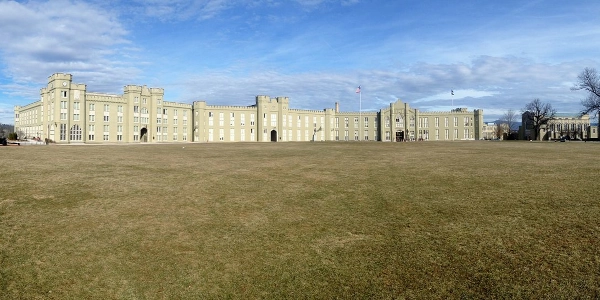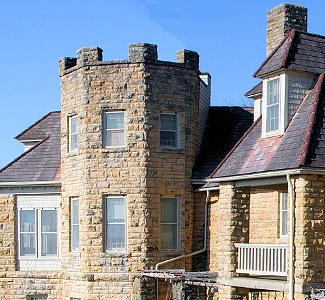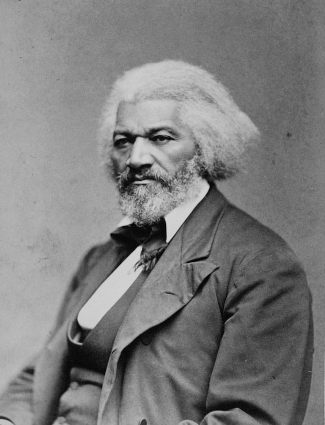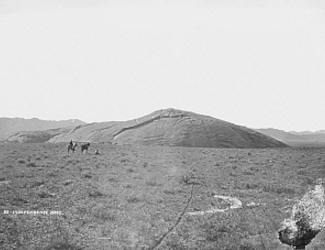
Photo above: Independence Rock on the Oregon Trail. First mentioned by Parker in 1835, and carries an inscription on the rock with the names of early trappers and explorers. Photo William H. Jackson, circa 1870. Photo courtesy National Archives. Right: Painting by Percy Moran, 1912, reflects the intensity of the battle of the Alamo. Photo courtesy Library of Congress.
Sponsor this page for $75 per year. Your banner or text ad can fill the space above.
Click here to Sponsor the page and how to reserve your ad.
-
Timeline
1839 - Detail
November 11, 1839 - In Lexington, Virginia, the Virginia Military Institute is founded.
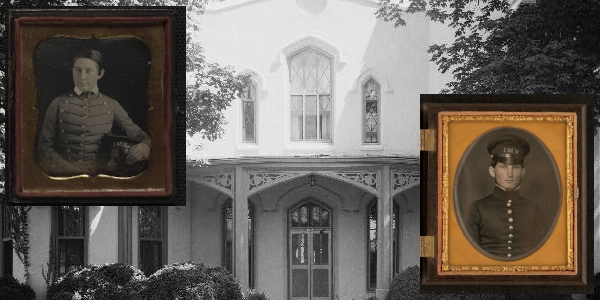
There was an armory in Lexington for munitions, one of several in the state of Virginia built after the War of 1812. The arsenel was guarded by soldiers who often drank too much and bothered the neighbors of Lexington. The community liked that the armory was there, as a guard against invasion or a slave revolt, but not who guarded it. So they devised a plan, which the state agreed to in 1836, that they would build a military institute, patterned after West Point, that could educate the young soldiers and they could guard the armory.
So, on November 11, 1839, the first cadet, John B. Strange of Scottsville, Va., took his post as first sentry, and he and twenty-two other classmates became the first at VMI. And yes, it was snowing. The United States as a nation was growing its educational institutions in 1839; colleges were springing up throughout the states and territories, including the first west of the Mississippi River, the University of Missouri. For the Virginia Military Institute, it would become known as the "West Point of the South," according to Abraham Lincoln, and the tradition of walking guard duty by the students is still upheld to this day.
Major General Francis H. Smith was the first superintendent of the school, as well as a professor of tactics. He was a graduate of West Point, and the founders, including lawyer and Colonel J.T.L. Preston, had a goal to produce "fair specimens of citizen-soldiers." In 1842, the first class graduated sixteen students. That has been its tradition now for over one hundred and seventy-five years.
There have been unique professors at the school, whose notoriety grew in later years after their work at VMI was done. Colonel Preston jumped from his founding status to be Professor of Languages. Thomas (Stonewall) Jackson, the Confederate General and right hand man to General Robert E. Lee, had been one of the professors since 1851 until the beginning of the war.

The Civil War and VMI
As the institute was situated in Confederate territory, VMI became a training ground for the Cadet Corps of the Confederacy, called into action fifteen times during the four years of conflict.
It's most noted engagement in the Civil War occured at the Battle of New Market, on May 15, 1864, when the entire student body, two hundred and forty-seven cadets, fought and turned the tide for the South. It is the only time in U.S. history, albeit on the wrong side of eventual right and victory, that all of the students of a university fought in battle together. Ten cadets were killed and forty-seven wounded.
Because of this, the Union considered the school a target to contend with, and starting on June 12, 1864, shelled the school as part of Sheridan's Valley Campaign. Only one of the main buildings, the superintendent's house, remained after the effort. In retaliation for the burning of the Virginia Military Institute, Jubal Early burned the town of Chambersburg, Pennsylvania west of Gettysburg. However, when the war ended in Southern defeat in the spring of 1865, the school was back in session by October 17, 1865.

History of VMI Through Today
By the early 1900's, the school had seven hundred cadets as students; in World War I, it is estimated that one thousand and four hundred graduates of VMI fought in that war. In World War II, the estimate grew to more than four thousand. It did take too long for the color barrier to break at VMI; not until 1972 were black students allowed to be cadets. Women did not become part of the population until 1997. Today, there are about one thousand seven hundred students at the university on its one hundred and thirty-four acre campus known as the Post. The Old Barracks remains as a reminder to the Union shelling with the New Barracks expanded numerous times since 1865.
Image above: Montage (background) Superintendent's House, unknown date, Historic American Buildings Survey; (left inset) Unknown cadet from VMI, 1845, unknown author; (right inset) Cadet A.G. Copenhaver, 1850's, unknown author. Courtesy Library of Congress. Below: New Barracks of VMI, 2014, nick40ghs. Courtesy Wikipedia Commons, C.C. 3.0. Info Source: vmi.edu; Wikipedia Commons; Library of Congress.
